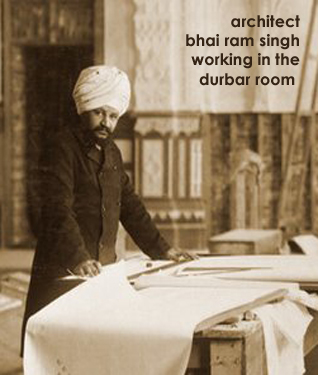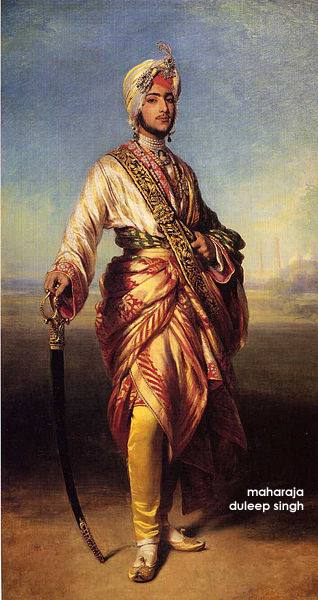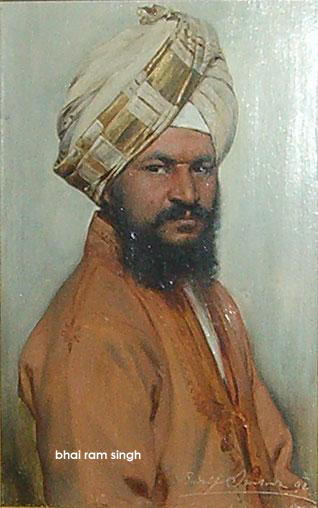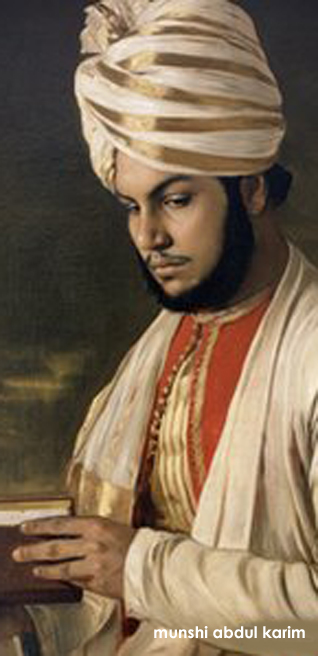Current Events
A Maharaja And A Munshi:
In Bhai Ram Singh's Durbar
by EMMA MIDGLEY
In the halls of Queen Victoria's family home on the Isle of Wight hang, inter alia, two portraits - of a Maharaja (Duleep Singh) and a Munshi (Abdul Karim).
The Queen never visited the subcontinent, but she had close friendships with these two men from very different backgrounds.
Abdul Karim came from a humble Muslim family, and was gifted to the Queen as a servant by the Raj as part of her Golden Jubilee celebrations.
He ended up as her Urdu teacher and close companion.
By contrast Duleep Singh came from a long line of Maharajahs, and was "adopted" by Queen Victoria as a teenager, growing up alongside her own children.
Coerced by his British captors into converting to Christianity while still a child, he became a country squire while in exile in Britain, before finally rebelling against the land of his exile and attempting to reclaim his Sikh kingdom.
THE LAST EMPERORNow a researcher from Berkshire has opened an exhibition in Berkshire as part of a project to explore Queen Victoria's links to the Raj.
Neena Sohal hopes to remind the Sikh community in Slough about their links to royalty.
She said: "Duleep Singh is well-known in the Sikh community as the last Maharajah, and also because his Sikh Empire owned the Koh-i-Noor diamond, which [was taken away from him to be] gifted to Queen Victoria.
"Queen Victoria had a strong motherly relationship with him, and saw him as a fellow royal.
"Even after he rebelled against the British Empire, she gave him a pardon."
Ms Sohal said Queen Victoria "felt guilty" about stripping the young Maharajah of his empire.
"In the end, his children had no children, so his family died out," she said.
"It was a tragic end."
URDU JOURNALMs Sohal said the Queen's relationship with Munshi Abdul Karim was not so well-known, due to its controversial nature.
"He started off as a table servant, but she obviously look a liking to him.
"He taught her Urdu, and she used it to entertain her various visitors from Sikh and Indian royalty.
"They used to keep an Urdu journal together."
Such Was Victoria's fascination with the subcontinent, she employed the great Sikh architect, Bhai Ram Singh, to create the Durbar Room at the Isle of Wight home, Osborne House, for state functions.
The room was decorated with several atifacts brought in from Punjab and the subcontinent.
In Osborne House, the famous portrait of Maharaja Duleep Singh, as well as one of Karim, both painted by painted by the Queen's favourite artist, Winterhalter, are on display, as well as portraits Queen Victoria commissioned of the citizenry of Punjab and the subcontinent, done at her behest to bring to her images of a land she could never visit.
Ms Sohal said the Queen was surprisingly modern in her views on people from other cultures.
"When people behaved in a racist way she would stand up to them," she said.
"She would give out 30 page memos to her staff, telling people not to call "tanned" people "black" or be prejudiced against them because of the colour of their skin."
However, following the Queen's death in 1901, Mr Karim also came to an unhappy end.
"Following the Queen's death in 1901, he was unceremoniously sent back to India," said Ms Sohal, by courtiers who were endlessly jealous of the influence he had had over their monarch.
"His family were hounded and any evidence linking him to the Queen was destroyed."
The exhibition In Court with Queen Victoria - A Maharajah and a Munshi, will run until Thursday, 5 April, 2012. at Slough Museum.
[Courtesy: BBC. Edited for sikhchic.com]
February 19, 2012
Conversation about this article
1: R. Singh (Canada), February 19, 2012, 10:53 AM.
Wan't Munshi Abdul Karim, child Duleep Sinh's attendant, when he was brought to England?






